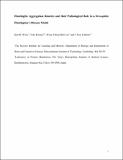| dc.contributor.author | Kimura, Yoko | |
| dc.contributor.author | Lee, Wyan-Ching Mimi | |
| dc.contributor.author | Littleton, J. Troy | |
| dc.contributor.author | Weiss, Kurt Richard | |
| dc.date.accessioned | 2014-03-10T17:52:56Z | |
| dc.date.available | 2014-03-10T17:52:56Z | |
| dc.date.issued | 2011-11 | |
| dc.date.submitted | 2011-08 | |
| dc.identifier.issn | 0016-6731 | |
| dc.identifier.uri | http://hdl.handle.net/1721.1/85583 | |
| dc.description.abstract | Huntington’s disease is a neurodegenerative disorder resulting from expansion of a polyglutamine tract in the Huntingtin protein. Mutant Huntingtin forms intracellular aggregates within neurons, although it is unclear whether aggregates or more soluble forms of the protein represent the pathogenic species. To examine the link between aggregation and neurodegeneration, we generated Drosophila melanogaster transgenic strains expressing fluorescently tagged human huntingtin encoding pathogenic (Q138) or nonpathogenic (Q15) proteins, allowing in vivo imaging of Huntingtin expression and aggregation in live animals. Neuronal expression of pathogenic Huntingtin leads to pharate adult lethality, accompanied by formation of large aggregates within the cytoplasm of neuronal cell bodies and neurites. Live imaging and Fluorescence Recovery After Photobleaching (FRAP) analysis of pathogenic Huntingtin demonstrated that new aggregates can form in neurons within 12 hr, while preexisting aggregates rapidly accumulate new Huntingtin protein within minutes. To examine the role of aggregates in pathology, we conducted haplo-insufficiency suppressor screens for Huntingtin-Q138 aggregation or Huntingtin-Q138–induced lethality, using deficiencies covering ~80% of the Drosophila genome. We identified two classes of interacting suppressors in our screen: those that rescue viability while decreasing Huntingtin expression and aggregation and those that rescue viability without disrupting Huntingtin aggregation. The most robust suppressors reduced both soluble and aggregated Huntingtin levels, suggesting toxicity is likely to be associated with both forms of the mutant protein in Huntington’s disease. | en_US |
| dc.language.iso | en_US | |
| dc.publisher | Genetics Society of America, The | en_US |
| dc.relation.isversionof | http://dx.doi.org/10.1534/genetics.111.133710 | en_US |
| dc.rights | Creative Commons Attribution-Noncommercial-Share Alike | en_US |
| dc.rights.uri | http://creativecommons.org/licenses/by-nc-sa/4.0/ | en_US |
| dc.source | Littleton | en_US |
| dc.title | Huntingtin Aggregation Kinetics and Their Pathological Role in a Drosophila Huntington's Disease Model | en_US |
| dc.type | Article | en_US |
| dc.identifier.citation | Weiss, K. R., Y. Kimura, W.-C. M. Lee, and J. T. Littleton. “Huntingtin Aggregation Kinetics and Their Pathological Role in a Drosophila Huntington’s Disease Model.” Genetics 190, no. 2 (February 1, 2012): 581–600. | en_US |
| dc.contributor.department | Massachusetts Institute of Technology. Department of Biology | en_US |
| dc.contributor.department | Massachusetts Institute of Technology. Department of Brain and Cognitive Sciences | en_US |
| dc.contributor.department | Picower Institute for Learning and Memory | en_US |
| dc.contributor.approver | Littleton, Troy | en_US |
| dc.contributor.mitauthor | Weiss, Kurt R. | en_US |
| dc.contributor.mitauthor | Kimura, Yoko | en_US |
| dc.contributor.mitauthor | Lee, Wyan-Ching Mimi | en_US |
| dc.contributor.mitauthor | Littleton, J. Troy | en_US |
| dc.relation.journal | Genetics | en_US |
| dc.eprint.version | Author's final manuscript | en_US |
| dc.type.uri | http://purl.org/eprint/type/JournalArticle | en_US |
| eprint.status | http://purl.org/eprint/status/PeerReviewed | en_US |
| dspace.orderedauthors | Weiss, K. R.; Kimura, Y.; Lee, W.-C. M.; Littleton, J. T. | en_US |
| dc.identifier.orcid | https://orcid.org/0000-0001-5576-2887 | |
| mit.license | OPEN_ACCESS_POLICY | en_US |
| mit.metadata.status | Complete | |
